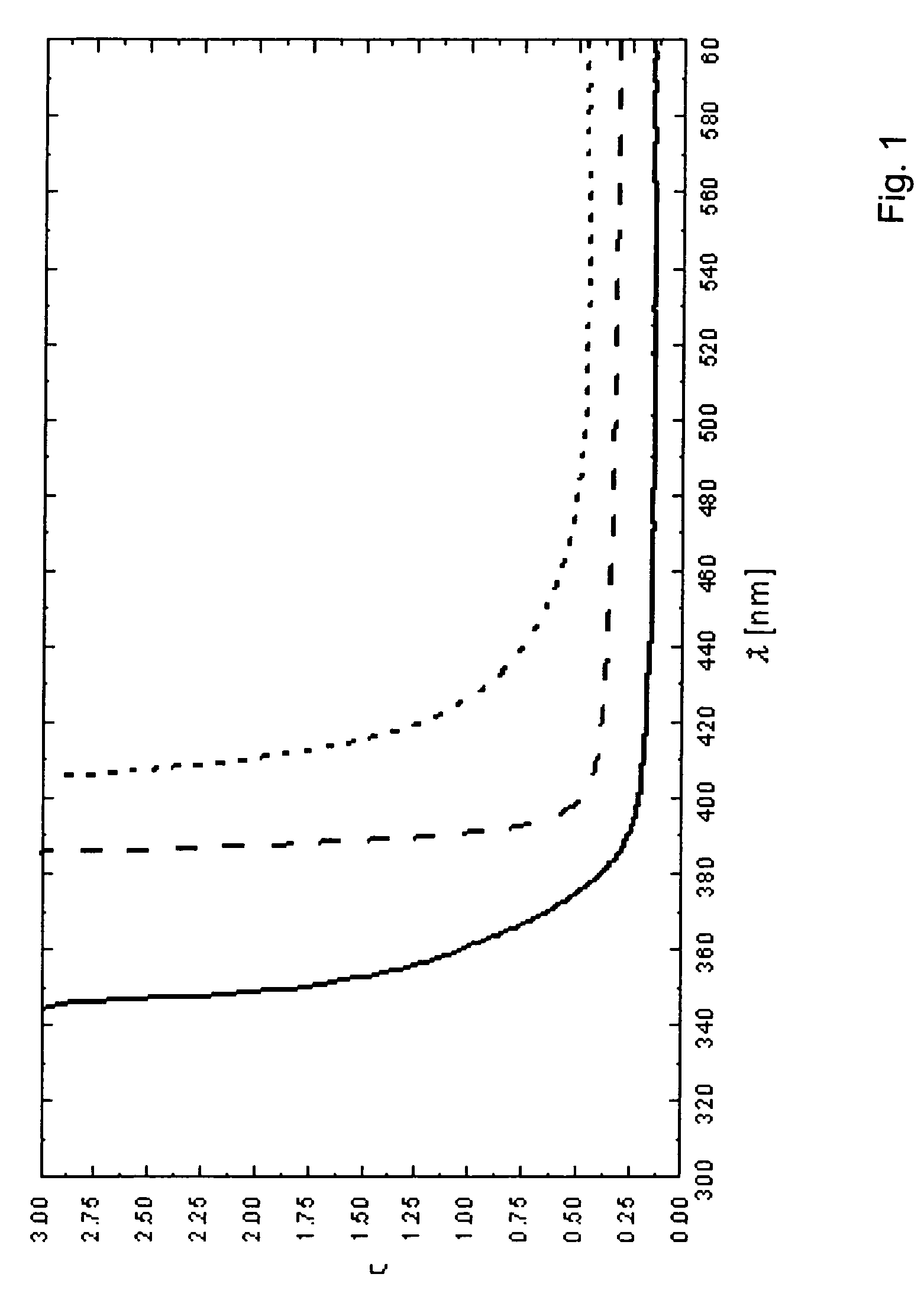Sulfur-modified zinc oxide
a technology of zinc oxide and sulfur compound, which is applied in the direction of spectral modifiers, aluminium sulfur compounds, alkali metal sulfites/sulfates, etc., can solve the problems of not being able to disclose the particle or powder of such a compound, and not being able to use the layers known from the prior ar
- Summary
- Abstract
- Description
- Claims
- Application Information
AI Technical Summary
Benefits of technology
Problems solved by technology
Method used
Image
Examples
example 1
Preparation of a Powder of a Compound of Formula ZnO1−xSx (x≦0.05)
[0031]Mixtures having the following compositions were prepared in separate investigations:[0032]21.78 mmol. ZnO / 0.22 mmol. ZnS[0033]21.56 mmol. ZnO / 0.44 mmol. ZnS[0034]21.34 mmol. ZnO / 0.66 mmol. ZnS[0035]21.12 mmol. ZnO / 0.88 mmol. ZnS[0036]20.90 mmol. ZnO / 1.10 mmol. ZnS
[0037]The grain sizes of the starting solids materials used were in each case in the range from 1 to 10 μm.
[0038]Each mixture accordingly comprises a total of 22 mol. of Zn. The mathematical value of x varied from 0.01 to 0.05.
[0039]The mixtures were each transferred to quartz-glass containers; the containers were evacuated and then filled with a small amount of bromine, closed and maintained at a temperature of 950° C. for at least 5 days. Single-phase, light-yellow powders of a compound of formula ZnO1−xSx were formed, the particles of the powder formed having a grain size in the range from 1 to 10 μm.
[0040]Note: In additional tests it was found that,...
example 2
Preparation of Crystals (Large Crystalline Particles) of a Compound of Formula ZnO1−xSx by Precipitation from the Gas Phase
[0041]Mixtures of ZnO and ZnS were prepared, for example a mixture consisting of 1701 mg (20.9 mmol.) of zinc oxide and 107 mg (1.1 mmol.) of zinc sulfide.
[0042]In a quartz-glass ampoule (inside diameter 10 mm; length 190 mm) in a horizontal two-zone oven, the mixtures were exposed to a temperature gradient of, for example, 1000° C.→900° C. A small amount of bromine (or alternatively a corresponding amount of a different halogen or of a halogen compound) was added as transport agent; the bromine pressure (starting pressure) was 0.5 bar. A plurality of light-greenish, intergrown ZnO1−xSx crystals having a size of several millimetres were obtained.
[0043]The lattice parameters of the ZnO1−xSx phases were determined by means of X-rays; they differ only slightly from those of pure ZnO: a=325.251(17) pm, c=520.906(6) pm, V=47.742(4)·106 pm3. ZnO (for comparison): a=32...
example 3
Preparation of a Powder of a Compound of Formula ZnO1−xSx by Precipitation from Solution
[0044]First step: Sodium hydroxide was added to an aqueous zinc salt solution, for example a saturated ZnSO4 solution, so that zinc hydroxide was obtained as precipitate. The zinc hydroxide was filtered off.
[0045]Second step: The precipitate was washed with distilled water until neutral.
[0046]Third step: The washed precipitate was suspended in water, and H2S gas was passed into the resulting suspension for 15 minutes. Alternatively, in different forms of the process, an aqueous H2S solution or another preparation that supplies sulfide ions was added.
[0047]The resulting precipitate was filtered off and then subjected to heat, preferably first for 12 hours at 500° C. and then for a further 12 hours at 800° C. The product was a light-yellow powder of a compound of formula ZnO1−xSx.
Analytical Methods
[0048]In our own investigations, the following analytical methods were used to determine the compositi...
PUM
| Property | Measurement | Unit |
|---|---|---|
| mean grain size | aaaaa | aaaaa |
| mean grain size | aaaaa | aaaaa |
| absorption edge | aaaaa | aaaaa |
Abstract
Description
Claims
Application Information
 Login to View More
Login to View More - R&D
- Intellectual Property
- Life Sciences
- Materials
- Tech Scout
- Unparalleled Data Quality
- Higher Quality Content
- 60% Fewer Hallucinations
Browse by: Latest US Patents, China's latest patents, Technical Efficacy Thesaurus, Application Domain, Technology Topic, Popular Technical Reports.
© 2025 PatSnap. All rights reserved.Legal|Privacy policy|Modern Slavery Act Transparency Statement|Sitemap|About US| Contact US: help@patsnap.com


